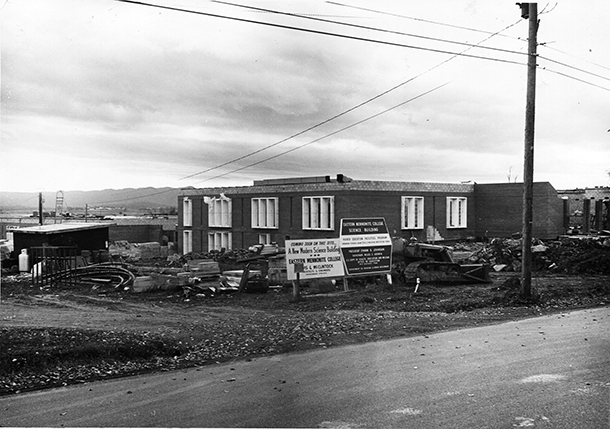Long ago, when the grounds of the Suter Science Center were just a cornfield on the east side of campus, and John Spicher ’58 was a biology major taking science classes in the basement of the old “Ad” building – since burned down and replaced by the Campus Center – some forgotten person procured some chemicals for some forgotten educational use.
And when, a decade later, that cornfield on the east side of campus sprouted a science building, capped with a prominent white dome to accommodate a then-state-of-the-art planetarium, those chemicals were carted down to the new laboratory supply closets, in the characteristic spirit of Mennonite thrift.
And when, many years later, Spicher returned to EMU to work as the chemical hygiene officer, he began a process of general inventory and cleanup of the no-longer-new laboratory supply closets, cluttered over the years by Mennonite thrift and other forces of entropy. And it was then with a sense of nostalgia that Spicher discovered some of those very bottles procured 50 years earlier when Spicher was an undergrad, and the Suter Science Center (where the bottles had sat just-in-case, like twist-ties in the kitchen drawer) was still a cornfield.
But it was alarm, not nostalgia, that arose when Spicher came across an old bottle of picric acid – a chemical useful for staining tissue when diluted with sufficient water concentration. When insufficiently diluted, however, picric acid forms explosive crystals. (A close chemical relative to TNT, picric acid played a major role in artillery science through World War I.) Spicher backed away, well aware that uncorking a crystallized bottle of old picric acid could cost him his fingers, or more. Mennonite thrift in the Suter Science Center had taken a potentially treacherous turn.
A Northern Virginia bomb squad was called in. The fire department sent personnel for some explosives training. A hole was dug behind the science center, a fuse was lit, and the picric acid bomb, unwittingly improvised in the chemical closet, was disarmed. In the end, says Spicher, the bang was small, but it pays to be careful with the stuff.
UNDERCOVER POET
Daniel B. Suter ’40, for whom the science center was named, joined the science faculty at what was then Eastern Mennonite College (EMC) in 1948. By the time the new building opened 20 years later, his students in the pre-med program enjoyed medical school acceptance rates far above the national average. So valuable was Suter’s recommendation that, according to faculty legend, a medical school candidate who had never even attended EMU tried to finagle a letter from Suter.
Suter’s office was in the science center basement, adjacent to the secretary’s office and the lunchroom, where the faculty regularly ate together while skimming the newspapers, telling jokes, chattering and generally enjoying one another’s company. For years, on their birthdays, personalized poems would appear on the lunch table, written by a mysterious poet who published under Salvelinus fontinalis (“Brook trout” in the jargon of scientists).
From a poem on the 64th birthday of Wilmer Lehman ’57, who joined the mathematics faculty in 1959:
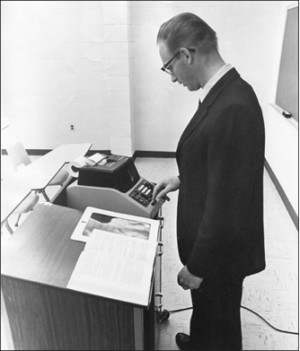
Forty years teaching
Is that what he said
How many functions
Are left in his head?
A teacher of Math
And The Liberal Arts
With much dedication
Gave his students some smarts.
Eventually, it came out that Salvelinus fontinalis was the pen name of Bob Yoder ’57, an enthusiastic fisher of S. fontinalis. Yoder, who taught in the biology department for more than 30 years, was the resident jokester of the science center lunch bunch; upon his death in 2005, a volume of his collected poems was distributed to his colleagues.
WOMEN NEED RESTROOMS TOO!
The Suter Science Center reflected its day and age when it opened in 1968. Science was mostly a man’s world then. There were no women on the permanent science faculty, and the college didn’t bother to put in a women’s restroom on the downstairs level; the secretary (always a woman, in those days) and female students had to go upstairs. Before long, agitation against the basic unfairness of this situation began and EMU kept pace with the changing world around it by establishing restroom equality throughout the building.
Because energy was cheap back when the building was built, insulation wasn’t much of a priority. When Lehman began to notice light streaming in large gaps that had opened up between the window frames and the block walls in his math classroom, physical plant staff came over to work at some retroactive solution. Still, the classrooms were a nice improvement over the “E Building,” a former egg processing plant on the south side of Mount Clinton Pike that housed the math department before the science center was built.
Over his four decades of teaching, Lehman taught just about every math class that was offered by EMU. One of the memories that stands out was the time a student answered a test question with an unexplained Bible reference. Lehman was tickled when he looked up Psalm 139:6 – Such knowledge is too wonderful for me, too lofty for me to attain.
Another long-time mathematics professor, Millard Showalter ’62 loved to encourage creative approaches to problem solving, and thus, routinely offered his Math in the Liberal Arts students an alternative and deceptively simple-sounding way to earn an A in the class: fold an 8 ½ x 11 sheet of paper in half eight times. The challenge was a fun illustration of exponents; making that eighth crease was like trying to fold 256 sheets of paper at once.
RESOURCEFUL GALEN LEHMAN
For years, Showalter’s students tried and failed, until Galen Lehman ’73 marched triumphantly into class one morning, with a look in his eyes that told Showalter his game was up. It had been easy, really. Lehman was supporting his college habit with a job at the Kreider Machine Shop over the hill from campus, where he had access to a 200-ton hydraulic machine press entirely capable of folding 256 sheets of paper.
Lehman also earned an A honestly in the class and went on to become Dr. Galen Lehman, chair of the EMU psychology department and the longest-serving member of today’s faculty. When Lehman joined the faculty, the department was inconveniently housed on the fringes of campus in the same E building that the mathematics folks had previously escaped. Looking for a more respectable location, Lehman settled on an unfinished, dirt-floored crawl space beneath the science center’s planetarium that had been presciently excavated to someday accommodate this very sort of future growth.
Around 1980, Lehman spearheaded the renovation of the space into what still serves as the psychology department. He personally poured the concrete floor, built a large table still in use in the seminar room, and, while breaking through a block wall to run some plumbing, discovered an empty whisky bottle in the wall cavity, likely hidden by a worker during the building’s original construction.
EARRING STUNTS & MORE WITH DEAD ANIMALS
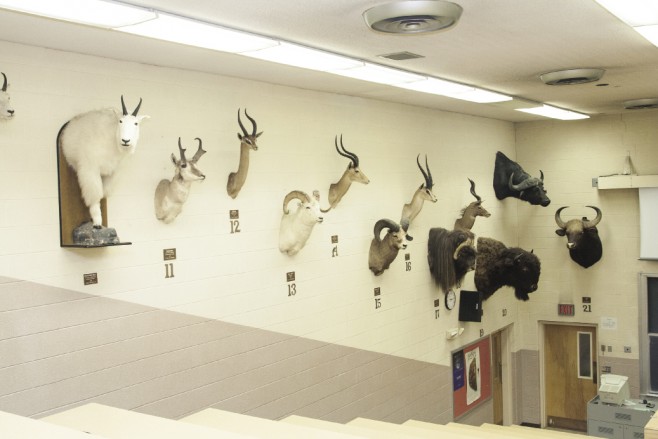
But let’s return to Showalter’s paper-folding assignment. Outmaneuvered by Lehman and his machine press, Showalter learned a lesson that science center faculty have been learning over and over since the building opened: never underestimate the dedication and creativity undergraduates will apply to various capers, tricks and other antics. The famous “Head Room” – SC 104, its walls lined with the mounted heads of various mammals – has been the scene of repeated pranks, often involving the dandying-up of these animal heads with different eyewear, headwear, jewelry and other fashion accessories.
Some of the faculty found this amusing. D. Ralph Hostetter, a professor of biology from the very earliest days of the Eastern Mennonite School until his retirement in 1966, did not. After retiring from teaching, Hostetter curated the natural history museum, now housing more than 6,000 artifacts and specimens (and now bearing his name). With hardly any acquisitions budget to speak of, he paid for most of the stuffed heads out of his own pocket. A highly meticulous man, he simply didn’t find it funny to discover the dik-dik (a tiny African antelope) wearing glasses and earrings.
For years, the sheer size and weight of the 300-lb. American bison specimen on display at the Hostetter Museum of Natural History seemed sufficient to keep it in place in the science center, though this too was an underestimation of the undergraduate determination to prank. In 2007, a posse from Oakwood made off with the stuffed bison and attempted to hoist it up to the three-story residence hall’s roof. When things went awry mid-hoist, however, both the bison and a 19-year-old freshman fell from the roof. The student was airlifted to the University of Virginia medical center with a concussion and fractured hip.
The freshman healed and the bison was none the worse for the experience. Now he stands in his old position at the entrance to the science center on a thick concrete platform, anchored with tamper-resistant bolts.
MASKED PRANKSTERS
On another occasion, while lecturing in the Head Room, physics and mathematics professor John Horst ’60 raised one of the sliding blackboards to discover the one behind it had been covered by a high-resolution enlargement of a Playboy centerfold. After the class regained its composure, Horst made a mental note to check for sliding blackboard surprises thenceforth.
That was not the most memorable sliding blackboard surprise of his career, however. For years, Horst and several colleagues team-taught a general humanities class covering art, music and literature in history. The large classes were held in SC 106, the biggest classroom on campus; it also saw frequent use as a recital hall, theater and general performance space before other buildings specifically designed for those purposes were built.
Hidden all the way behind several layers of sliding blackboards in SC 106 was a chemical hood, a relatively large space where professors could safely demonstrate various experiments and reactions. For some time, Todd Weaver ’87 had been aware that the chemical hood could also be accessed from behind, through a storage room, and early in the second semester of his senior-year humanities class, he and a classmate “hatched a brilliant plan,” as he remembers it.
Wearing nothing but boxer shorts and monster masks, and armed with loaded super-soakers, Weaver and his accomplice climbed into the chemical hood from the storage room and waited for class to begin, hidden behind the blackboard. Horst was lecturing in front of the class when the two sprang into action. One by one, the sections of blackboard begin sliding up, eventually revealing the water gun bandits crammed in the chemical hood.
“We caused total chaos,” says Weaver, now a dentist active in EMU’s alumni association. They sprayed at least two of the professors in the room, and unloaded their super-soakers on their classmates as they fled up the auditorium’s two aisles. “The goal was to empty the water by the time we reached the back of SC 106 and sprint out the doors and run for the dorm,” says Weaver, who lived in Oakwood and therefore stands proudly in a long and distinguished tradition of campus mischief.
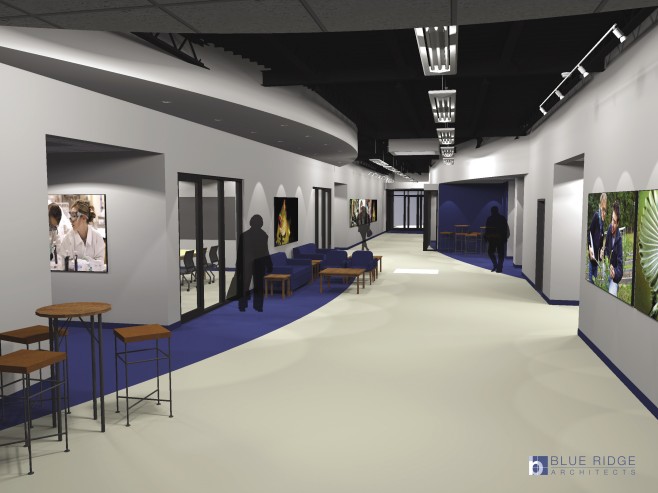
In what turned out to be a serious lapse of judgment, however, Weaver had let a few other friends in on the plan. And when Weaver and his accomplice reached the back of the room, their prank complete except for the get-away, they found the doors barred with two-by-fours.
“I will never forget Doug Geib ’87 with a big smile on his face unwilling to unbar the door. I was screaming [at him] to give in and let us out, but he only laughed,” Weaver remembers.
Language and literature professor Carroll D. Yoder ’62, one of Horst’s co-teachers in the room that morning, marched slowly up the steps and unmasked the pranksters, who could do nothing but stand with heads hanging, trapped with empty squirt guns at the back the room in their underwear. Ashamed, they walked back to Oakwood, changed clothes, and returned to catch the end of the humanities class. (Horst got one last hurrah. When Weaver approached Horst and asked humbly for one extra point to make a much-coveted “A” for the term, which was needed to maximize his chance of dental school admission, Horst made him squirm in his office for some long moments and then declared he would receive one more point in recognition of his “energetic class participation.”)
EXPERIMENTING, LIVING, BANKING IN THE CENTER
One damp Saturday morning an undergraduate chemistry major named Terry Jantzi ’87 was running an experiment that sent a bunch of sulfur dioxide through the lab hood. Normally it would have drifted off into the blue Virginia sky. But the cool, humid weather caused the sulfur dioxide to condense into a heavy fog that spread across the intramural soccer field – think “acid rain” recalls professor emeritus Glenn M. Kauffman, class of ’60, Janzti’s chemistry prof at the time. Folks at an auction near the dormitories thought the science center was on fire.
That same Terry Jantzi is now Dr. Jantzi, professor of practice associated with EMU’s peacebuilding and development program.
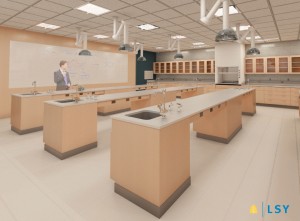
There was the time in 1976 that Millard Showalter’s Modern Geometry students got so jazzed about the non-Euclidian material he was teaching that they showed up to the final day of class wearing T-shirts that read “Millard’s Magnificent Mathematicians.” They arranged for a photo, and after class, went up to chapel and set together at the front, as proud as a bunch of athletes after winning a tournament.
Kauffman recalls his chemistry department colleague Gary L. Stucky putting money into a satellite dish on the science center roof in the early 1990s. This enabled him to watch concurrently three different TV channels late into the night in a prep room near SC-106, where he liked to pass his time outside of regular work hours. In the early 1990s, too, a dietetics program headed by Janet Harder ’73 moved into the science center and she also spent long hours at the workplace. By the late 1990s, Stucky and Harder were married, re-settling in his home state of Kansas.
The Park View Federal Credit Union began in 1969, in the Suter Science Center offices of professors Robert Lehman ’50 (physical sciences) and Joe Mast ‘64 (math and computer science), offering financial services to members in the days before easy access to credit. Many of their science center colleagues were the very earliest members. John Horst still has a single-digit account number at the credit union, and says that the credit union’s assets were said to be approaching $1 million by 1980, when it moved off of campus. (Kauffman remains the proud holder of an account number in the low double digits.)
Kenton Brubaker’s two-digit account number – between Kauffman’s and Horst’s – at the credit union gives him away as another early denizen of the science center. A 1954 grad of EMU, Brubaker returned as a horticulture and botany professor well before the science center was built. Up in the old science department, in the Ad Building basement, Brubaker secured grant funding to buy a gas flow analyzer capable of detecting Carbon-14 beta particles. With Brubaker’s help, another colleague, Merle Jacobs, used the tool to examine the low reproductive fitness of homozygous ebony Drosophila fruit flies. The resulting paper – “Beta-Alanine Utilization of Ebony and Non-ebony Drosophila melanogaster” [Science 139 (1963): 1282-1283] – was likely the first science research published in a major journal by EMU faculty.
Jacobs soon left for a job at Goshen College, and Brubaker was in the first wave of professors to work and teach in the new science center. The greenhouse had an automatic ventilation system – a big deal at the time. The planetarium was another big-ticket item. The whole building was exciting and new and fantastic. No sooner had the science department moved in then did Kauffman begin writing grants for other exciting gadgetry. A gas chromatograph and a UV-visible spectrophotometer were among the early acquisitions, allowing for undergraduate chemistry research that has continued ever since. (Students now enjoy research opportunities in a variety of science fields, usually collaborating with faculty.)
AHHH, THE MEMORIES, THE LEGACIES!
By the time Todd Weaver, of SC 106 chemical hood ambush fame, arrived on campus to pursue pre-medical studies, Daniel Suter was approaching the very end of his years on the EMU faculty. On his first visit to Suter’s office for an advising appointment, Weaver learned that Suter had also been Weaver’s father’s pre-med adviser years earlier, and they had corresponded for years while Weaver’s father was in medical school.
Between his graduation and the start of dental school, Weaver got married to Anne Kaufman ’88. Suter – then recently retired – and his wife, Grace were in attendance, and presented the Weavers with an end table.
Suter passed in away in 2006. The next year, Weaver was elected president of the Mennonite Medical Association; joining him in the leadership of the organization was Janice Showalter, the daughter of Daniel and Grace Suter.
“Life feels like it circles sometimes, especially in a community like EMU,” says Weaver.
The end table that the Suters gave him has moved with the Weavers from house to house since dental school. It remains a treasured possession that has been relocated every time in the family car rather than the moving truck, and it largely owes its prominence to the many people and memories that have and continue to inhabit the Suter Science Center.
— Andrew Jenner ’04
